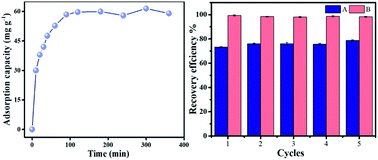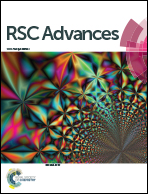Facile fabrication of ion-imprinted Fe3O4/carboxymethyl cellulose magnetic biosorbent: removal and recovery properties for trivalent La ions
Abstract
An Fe3O4/carboxymethyl cellulose (Fe3O4/CMC) magnetic biosorbent was prepared using the ion-imprinting technology, where La(III) was used as the template ion. The morphology and structure of Fe3O4/CMC were characterized by SEM, FTIR and XRD. It is found that nano Fe3O4 with inverse spinel structure can distribute in CMC and endow the composite with good magnetic properties. The adsorption performance such as adsorption capacity, influence of pH and initial concentration were fully explored. The prepared Fe3O4/CMC is revealed to have good adsorption properties with Qmax of 61.5 mg g−1, in line with the pseudo-second-order kinetic model. When handling the multi-ion coexistence solution of Cu(II), Ni(II) and Cd(II), Fe3O4/CMC shows high selective adsorption for La(III). Meanwhile, cycling experiments find that the adsorption capacity is only slightly reduced (less than 5%) after 5-time reuse. Good adsorption properties, high selectivity and easy recovery give the newly-synthesized Fe3O4/CMC biosorbent broad application potential in the treatment of La(III)-containing wastewater.



 Please wait while we load your content...
Please wait while we load your content...